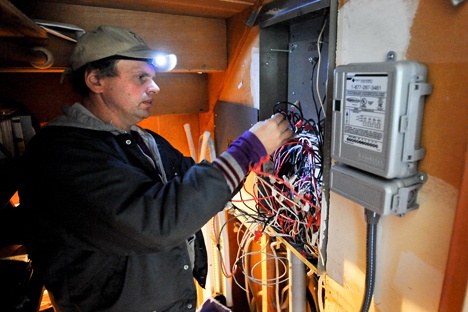More than 350 Bainbridge Island residents have signed up to participate in the Demand Response Program launched by Puget Sound Energy in cooperation with the Bainbridge Island Community Energy Task Force.
The two-year pilot program will test new technology that enables PSE to automatically manage customer’s energy consumption during peak-load times.
On a few days last winter, temperatures plummeted during a burn ban. When Bainbridge residents turned up their thermostats simultaneously, Puget Sound Energy’s transformers neared system capacity, according to the PSE Web site. These “peak-demand” spikes are short-lived and temperature-driven, but as the island’s sole electrical provider, PSE intensified its search for solutions, both short- and long-term, that would ensure its ability to meet market demand.
One option, and one that PSE is still considering, is to increase capacity by building a fourth sub-station on the island at a cost of $6 million.
Another option is energy conservation – residents simply not using as much energy – or, more specifically, residents not using energy all at the same time. With that in mind, the Demand Response Program, which new technology has made possible, allows PSE more control over energy use during critical periods. In the same way that stoplights on freeway onramps manage rush-hour-only traffic, the technology will stagger use among customers, but only during peak-load “events.”
“This is actually an opportunity, because it allows us a real-world test of technology that may help us delay the need to build a new substation,” said Cal Shirley, vice president of Energy Efficiency Services for PSE.
During a peak-load event, PSE will either reduce or block energy consumption in 15-minute cycles for up to four hours at a time. Because there are only a handful of events each season and the downtime is so small, participating customers will not see much difference in their power bill. What it may do is postpone higher costs for energy that would be incurred if PSE has to build another substation.
Kevin Soroko, director of Operation Support Services for GoodCents, the company contracted by PSE to launch and monitor the test program, said the goal is to find the balance between customer comfort and energy reduction.
“We don’t want people sitting at home with their coats on,” he said. The program is designed for long-term sustainability and much of that has to do with customer satisfaction. The test period, and the data gathered, will allow PSE to find that balance before introducing the technology island-wide.
Often, getting customers to warm to the idea of the utility company having control over their energy usage takes some effort.
“We launch these programs all over the country, and one of the challenges of my job is getting enough enrollment,” Soroko said.
Even PSE had warned the Energy Task Force that getting the 600 customers needed to volunteer for the program might take several months, said Hilary Franz, a member of the City Council and chair of the task force. She was one of the first residents to sign up for the pilot program. Instead, the program received more than 350 participants in the first 11 days Franz said.
“In my opinion, it’s because Bainbridge is more environmentally conscious,” Soroko said. “People here are looking for ways to not have to build another substation.”
Much of that is attributable to the task force’s energy awareness campaign, Franz said, adding that the real possibility of a substation may have helped catalyze residents into action.
Island residents who wanted to explore other alternatives – energy conservation education and renewable energy sources – organized a public meeting which led to the creation of the Energy Task Force, a community-wide alliance that has brought together citizens, energy consultants, city officials, nonprofits, interfaith groups and PSE to craft a community-wide energy plan.
The comprehensive plan is in the early stages of implementation, and one of the key components is PSE’s Demand Response Program. It requires installation of a lunchbox-sized control panel that uses cutting-edge Zigby chips to interface with electric heating and water heaters, the energy hogs of residential usage. The box will allow two-way communication via the Internet to remotely limit energy consumption during the peak-demand events. Customers can override the automatic limit on a case-by-case basis by calling PSE to opt out.
The installation took about two hours in Franz’s 1906 home. Installation in newer homes with bundled wiring and Internet cabling may take less than an hour. Soroko estimates that, at roughly 100 installations per week, 600 homes can be demand-response ready by the middle of December, just in time for winter. Most events will occur between November and February in the early morning when electric space and water heater use is highest. PSE also will schedule a few events between May and September 2010 to collect data about air-conditioning and water heating demand.
In order to participate in the pilot, single-family Bainbridge Island residential electric customers need a broadband Internet connection and electric space and water heat. For each full year a customer is enrolled, PSE will give a $50 credit as a thank-you gesture.
For more information about the pilot program, call PSE at 877-287-3461 or visit PSE.com. For more information about the Energy Task Force, email bienergychallenge@gmail.com.



